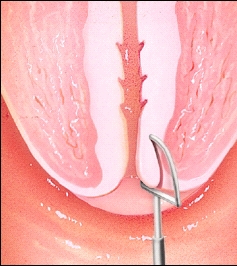Cone Biopsy
Cone Biopsy
A cone biopsy is a quick outpatient surgery used to find and treat a problem in the cervix. Your healthcare provider may do a cone biopsy if 1 or more Pap tests and a colposcopy (microscope) exam showed abnormal cells on your cervix. A cone biopsy takes less than an hour. You’ll be able to go home the same day. The most common type of cone biopsy is the loop electrosurgical excision procedure (LEEP). A wire with electric current is used to take the biopsy.

Preparing for a cone biopsy
Follow any directions you are given for not eating or drinking before surgery. You’ll also need to have an adult friend or family member drive you home after the procedure. On the day of surgery, be sure to arrive at the hospital or surgery center in time to sign in and get ready for your procedure.
Your surgery
Here is what to expect during surgery:
-
You’ll be given anesthesia before your biopsy to keep you comfortable during surgery.
-
Your healthcare provider then puts a thin metal tool (speculum) into your vagina to spread it open. This allows your health care provider to see your cervix.
-
Then a cone-shaped piece of tissue is removed from the cervix. The tissue is cut from the opening up into the canal. This may be done with a small knife or with a laser or with the LEEP wire.
-
A special cream may be put on your cervix to control bleeding.
-
The tissue that is removed is then sent to the lab. The lab studies the tissue and makes sure the abnormal cells have been cut away. New tissue grows back in the cervix in 4 to 6 weeks.
Recovery from a cone biopsy
After the procedure, you may have:
-
A pink, liquid discharge
-
Mild cramps
-
A dark-colored discharge (from the cream used)
Don’t use tampons, don’t douche, and don’t have sex until your healthcare provider says it's OK.
When to call your healthcare provider
Call your healthcare provider if you have:
-
Heavy bleeding, or bleeding with clots
-
Fever over 100.4°F (38°C) or higher, or as directed by your provider
-
Chills
-
Bad-smelling vaginal discharge
Your healthcare provider will discuss the risks and possible complications of cone biopsy with you. These include:
-
Not removing all of the abnormal tissue
-
Severe bleeding
-
Infection
-
Weakening or scarring of the cervix that could lead to preterm birth
Updated:
March 16, 2019
Sources:
Cervical intraepithelial neoplasia: Procedures for cervical conization. UpToDate
Reviewed By:
Burd, Irina, MD, PhD